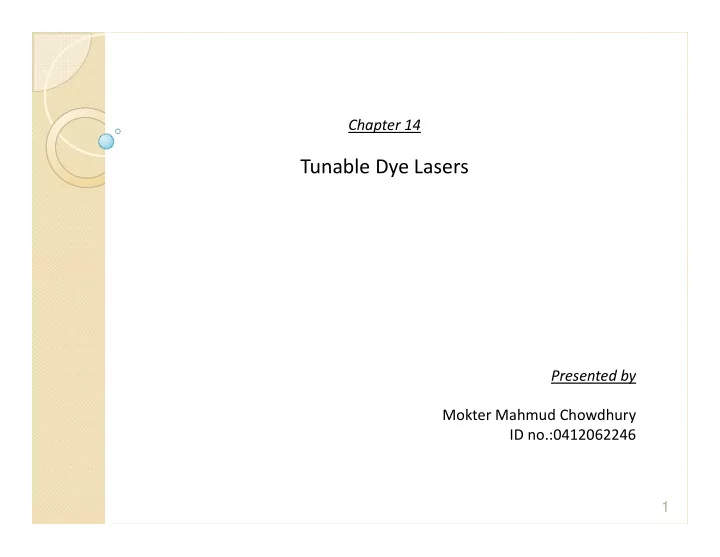

Chapter 14 Tunable Dye Lasers Presented by Mokter Mahmud Chowdhury ID no.:0412062246 1
Tunable Dye Lasers: - In a dye laser the active lasing medium is an organic dye dissolved in a solvent such as alcohol. - The major advantage of this laser over other types is continuous tunability over a wide range. - These lasers may be pumped by either flashlamps or by another laser. laser. - Laser-pumped dye lasers normally employ nitrogen or excimer pump lasers and hence are pulsed. - Continuous dye lasers are possible using a CW argon-ion laser as a pump source. Emitting yellow light under the influence of a green laser [1]. [1] http://en.wikipedia.org/wiki/Dye_lasers 2
Lasing Medium: - Active lasing medium is an organic dye dissolved in a solvent such as alcohol. - Incident energy is absorbed by the dye, exciting it from the lowest singlet state to a high-energy level within the upper singlet band. - From the high-energy level the dye - From the high-energy level the dye falls to a slightly lower state within the same singlet band, which serves as an upper lasing level. - A laser transition can then occur between the upper lasing level and the lower singlet state, which serves as a lower lasing level. Laser dye energy levels 3
Lasing Medium (cont…): - Because triplet states have lower energies than corresponding singlet states, dye molecules can easily migrate to those states and in doing so depopulate the upper lasing level. - Triplet states are metastable and have much longer lifetimes than the singlet levels. singlet levels. Flashlamp being Laser dye energy levels fired - When a short pump pulse such as that from a nitrogen laser (at 10 ns) is employed, triplet states do not form and do not present a problem for lasing. But when a flashlamp is used, triplet states can form. - For this reason, flashlamps must be designed to discharge as quickly as possible. 4
Laser Structure: Flashlamp-pumped dye laser configuration. configuration. - Circulation of the dye is required to keep the temperature of dye across the cell consistent. - If one region of the dye is warmer than another region, a thermal gradient develops. - A difference of indexes of refraction of liquid in the dye cell is developed which degrade the laser oscillation. 5
Laser Structure (cont…): Other configurations for a flashlamp-pumped dye laser: - A slab configuration is used in which the dye cell is formed between two slabs of glass that have a different index of refraction than the dye solution between the slabs. - Total internal reflection confines light within the cavity, producing a long optical path and hence large amplification. 6
Laser Structure (cont…): Laser pumped dye laser: Flash Laser-pumped dye Flash Laser-pumped dye laser - The pump laser beam is focused to a line on a dye cell using a cylindrical lens. - Penetration of the pump light into the cell is minimal, and essentially all is absorbed within the first few millimeters of dye within the cell. 7
Laser Structure (cont…): CW dye laser: - CW dye laser pumped by a CW laser source such as an ion laser. - In this case the biggest problem becomes heat management and degradation of the dye itself. - Both problems are alleviated by forming the dye into a continually flowing sheet of liquid called a laminar flow. CW dye laser 8
Laser Structure (cont…): CW dye laser: - Dye flow helps suppress the effects of -Fast dye flow is hence required to triplet absorption in the dye by ensuring ensure that dye molecules are a fresh supply of dye in the area exchanged before triplet absorption irradiated by pump laser light. becomes problematic and affects lasing action. CW dye laser 9
Optics and Cavities: - A grating is used to render a spectral output width. - A beam-expanding telescope is used in the cavity Optics for a dye laser - The telescope can also collimate the highly divergent beam exiting from the dye cell. - An etalon is included to reduce output bandwidth. 10
Output Characteristics: - The output characteristics of a dye laser are highly dependent on the optics employed. - Use of a diffraction grating alone as a wavelength selector renders a spectral width of 0.01 nm - Use of an etalon along with a diffraction grating can render spectral widths as low as 0.0005 nm. 11
Applications: - As a source for spectroscopy, the dye laser is ideal given the wide range over which tuning may be accomplished and the narrow spectral width of the output. - It is used atomic absorption spectroscopy. - Compact flashlamp-pumped dye lasers are occasionally employed in the field of ophthalmology for retinal photo- coagulation. 12
Thank You Thank You 13
Recommend
More recommend